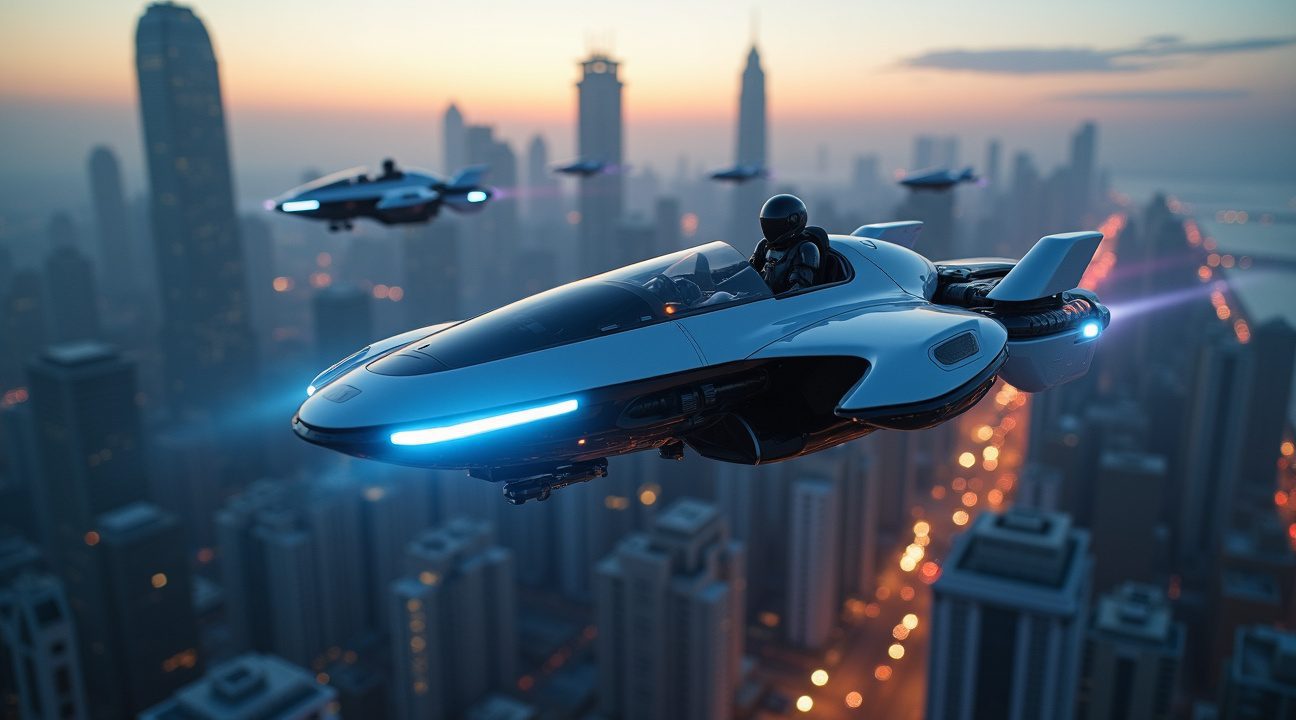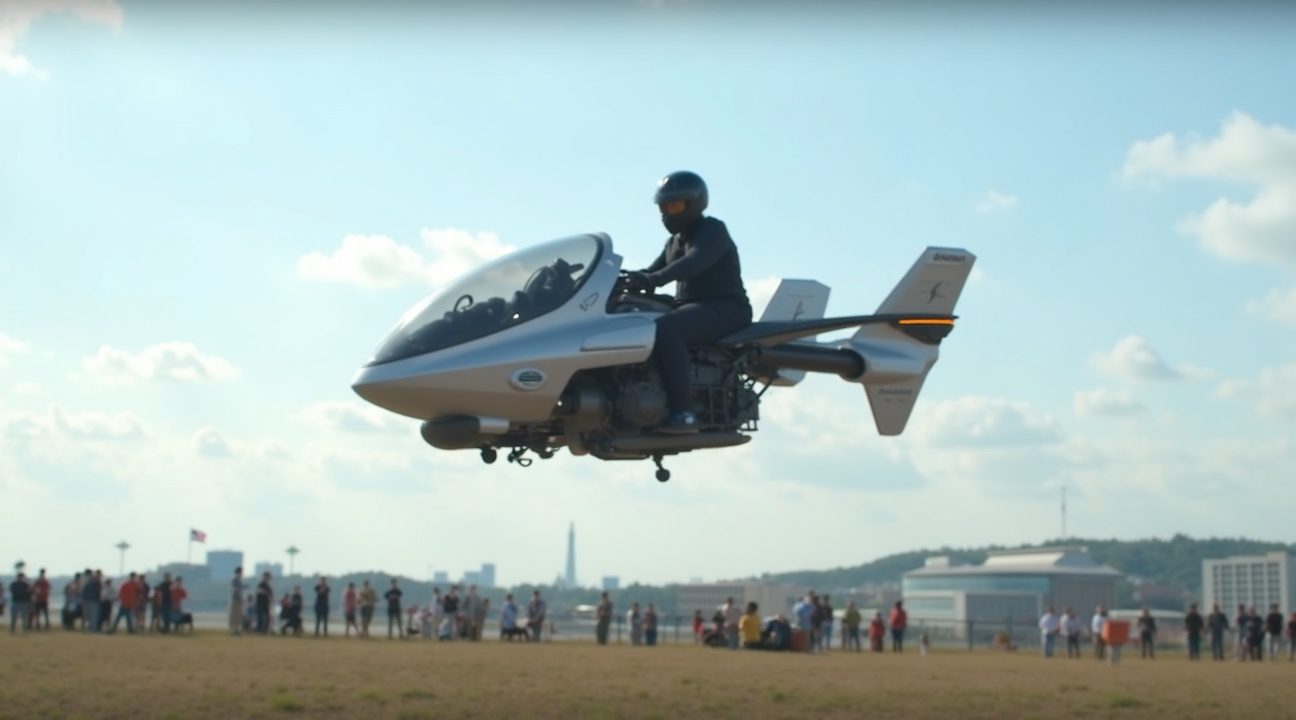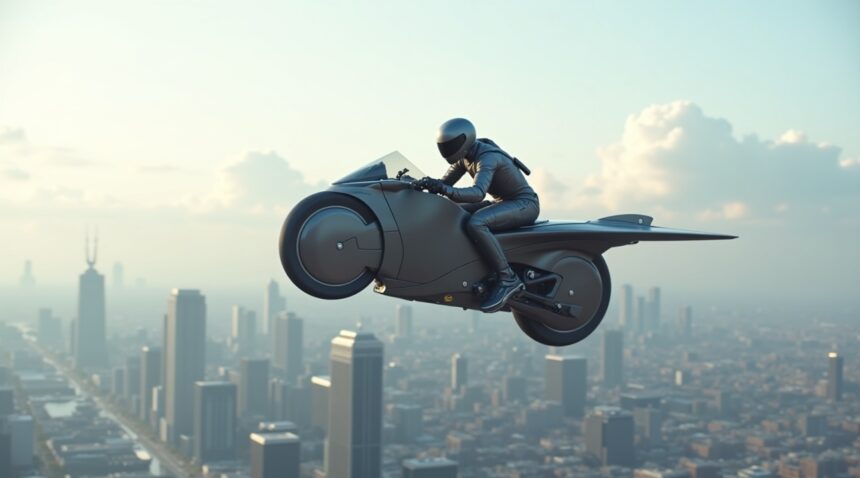Volonaut’s Airbike represents a transformative leap in personal aviation, merging futuristic speed with advanced engineering in a sleek and lightweight design.
Key Takeaways
- Record-breaking performance: The Airbike hits speeds up to 124 mph while weighing just 86 pounds, making it over seven times lighter than traditional motorcycles with unmatched performance capabilities.
- Advanced jet propulsion system: Unlike other personal aircraft that depend on electric ducted fans or rotors, the Airbike integrates compact jet technology for lower noise, superior aerodynamic efficiency, and reliable thrust under diverse conditions.
- Beginner-friendly flight technology: Proprietary stabilization and automated hovering systems enable intuitive control akin to riding a motorcycle, lowering barriers for new pilots and requiring minimal flight experience.
- Open-air immersive experience: With a minimalist skeletal carbon fiber frame and 3D-printed structural components, the design removes traditional cockpit constraints and grants full 360-degree visibility, producing a sensation similar to sci-fi speeder bikes.
- Proven development team: Spearheaded by Tomasz Patan, the visionary behind Jetson ONE, the Airbike has undergone successful prototype testing and public demonstrations, establishing its foothold in the fast-growing personal air mobility sector.
Jet-Powered Flying Motorcycle Breaks Speed Records at 124 mph
Volonaut’s Airbike has achieved something remarkable in personal aviation. This jet-powered flying motorcycle reaches a top speed of 124 mph (200 km/h), positioning it as one of the fastest personal flying vehicles in its proposed class. These impressive speeds demonstrate how advanced engineering can push the boundaries of what’s possible in personal flight technology.
Lightweight Design Meets Powerful Performance
The Airbike weighs approximately 86 lbs (39 kg), making it about seven times lighter than a typical motorcycle, which averages 600 lbs (272 kg). This dramatic weight reduction doesn’t compromise performance – instead, it enhances it. The lightweight construction allows for better maneuverability and efficiency while maintaining structural integrity during flight operations.
Engineers have achieved this remarkable weight-to-performance ratio through careful material selection and design optimization. The reduced weight directly contributes to the vehicle’s impressive speed capabilities and extended flight duration.
Advanced Flight Technology and Capabilities
The jet-powered motorcycle features VTOL (vertical take-off and landing) capability enabled by a unique jet propulsion system. This technology eliminates the need for runways or lengthy takeoff distances, allowing pilots to launch and land in confined spaces. VTOL capability makes the Airbike practical for urban environments where traditional aircraft would be impractical.
Flight time lasts up to 20 minutes per charge, providing sufficient duration for short-distance travel and recreational flights. While this might seem limited compared to traditional motorcycles, it’s competitive within the emerging personal flying vehicle market. The 20-minute flight window allows for meaningful trips while maintaining safety margins for landing.
The jet propulsion system sets this vehicle apart from other personal flying devices that rely on rotors or propellers. Jet propulsion offers several advantages, including:
- Reduced noise levels compared to helicopter-style aircraft
- Improved aerodynamic efficiency at higher speeds
- Compact design with fewer moving parts
This propulsion method contributes significantly to achieving those record-breaking speeds of 124 mph.
Key features that define the Airbike include:
- Top speed of 124 mph
- VTOL capability
- Jet propulsion system
- Lightweight build
- Classification as a personal flying vehicle
Each of these elements works together to create a unique transportation solution that bridges the gap between motorcycles and aircraft. The combination of speed, agility, and vertical flight capability opens up new possibilities for personal transportation.
The Airbike’s performance metrics place it in an exclusive category of high-speed personal flying vehicles. Unlike traditional motorcycles that are limited to ground travel, this vehicle offers three-dimensional mobility while maintaining speeds that rival flying car technology. The 124 mph top speed isn’t just impressive for a flying vehicle – it’s competitive with many ground-based motorcycles as well.
Safety considerations are built into the design through:
- Multiple redundant systems
- VTOL capability for emergency landings in varied terrain
- Low kinetic energy due to lightweight construction
- Reliable jet propulsion throughout the flight envelope
For potential users, the Airbike represents a significant step forward in personal mobility. The combination of motorcycle-like speeds with aircraft-like freedom creates opportunities for commuting, recreation, and emergency services applications. The 20-minute flight duration is well-suited for short hops between locations, aerial photography, or recreational flying.
The classification as a personal flying vehicle places the Airbike in a regulatory category that’s still evolving. This positioning could influence how future aviation authorities handle licensing, airspace usage, and safety requirements for similar vehicles. The record-breaking speed of 124 mph demonstrates that personal flying vehicles can achieve performance levels previously reserved for larger, more complex aircraft.

Revolutionary Design Delivers Star Wars Speeder Bike Experience
Volonaut’s Airbike brings science fiction closer to reality with its groundbreaking approach to personal aviation. I find the minimalist design philosophy creates an experience that closely mirrors the iconic speeder bikes from Star Wars, offering riders an unprecedented sense of freedom and immersion.
Advanced Materials and Construction
The Airbike’s skeletal frame relies heavily on advanced carbon fiber construction combined with cutting-edge 3D-printed components. This material combination delivers exceptional strength while maintaining ultra-lightweight performance characteristics. Carbon fiber provides the structural integrity needed for flight operations, while 3D-printed parts allow for complex geometries that wouldn’t be possible with traditional manufacturing methods.
Unlike conventional personal flying vehicles that depend on exposed rotors or wing structures, this aircraft employs jet propulsion for directional thrust. This innovative approach eliminates the need for visible propellers or wings, creating a compact form factor that maintains the sleek aesthetic riders expect from futuristic transportation.
Immersive Open-Air Experience
The open-air configuration sets the Airbike apart from traditional aircraft designs. With no roof, screens, or traditional cockpit elements, riders enjoy an unobstructed 360-degree view of their surroundings. This design choice creates a strong sensation of freedom that enclosed cockpits simply can’t match.
Riders straddle the Airbike in a motorcycle-like position, gripping handlebars while seated on an open seat. The absence of traditional shielding or protective barriers enhances the immersive experience, though it requires careful consideration of safety protocols and operating conditions.
Key design elements that define the Airbike experience include:
- Carbon fiber frame construction for optimal strength-to-weight ratio
- 3D-printed components enabling complex, lightweight structures
- Minimalist skeletal design eliminating unnecessary bulk
- Complete visibility with no obstructing panels or screens
- Motorcycle-style seating position for intuitive control
This revolutionary approach to personal aviation design creates an experience that feels more like flying car technology than traditional aircraft operation. The combination of advanced materials, innovative propulsion, and open-air design philosophy delivers the closest approximation to science fiction speeder bikes that current technology allows.
Advanced Flight Technology Makes Piloting Accessible to Beginners
Volonaut’s Airbike breaks down traditional barriers to flight through cutting-edge technology that transforms an inherently complex activity into something surprisingly approachable. The aircraft’s proprietary stabilization system serves as the foundation for this accessibility, working continuously to maintain balance and stability without requiring constant pilot input.
The flight computer acts as the brain behind this simplified operation, processing multiple data streams in real-time to keep the Airbike stable and responsive. This sophisticated system enables automatic hovering capabilities, allowing pilots to maintain position effortlessly while they familiarize themselves with the controls. Unlike traditional aircraft that demand extensive training and certification, the Airbike’s computer handles much of the technical complexity behind the scenes.
Control input feels remarkably natural, drawing inspiration from familiar experiences rather than forcing users to learn entirely new motor patterns. Piloting resembles leaning forward on a sport bike, tapping into muscle memory that many people already possess. This intuitive approach eliminates the steep learning curve typically associated with aviation, making flight accessible to individuals without any prior piloting background.
Innovative Safety Through Intelligent Design
Volonaut’s engineering approach prioritizes safety through technology rather than traditional protective measures. The absence of seatbelts or protective cages reflects a fundamental shift in aviation safety philosophy, placing complete reliance on advanced stabilization and balance innovations. This design choice demonstrates confidence in the underlying flight systems while maintaining the open, motorcycle-like experience that defines the Airbike concept.
Database and patent research reveals Volonaut’s commitment to integrating user-friendly technologies that could establish new benchmarks for both performance and safety in personal aviation. The company’s development strategy focuses on making advanced flight capabilities accessible to everyday users, similar to how flying car technology continues to evolve for mainstream adoption.
The stabilization system continuously monitors flight conditions and pilot inputs, making micro-adjustments that keep the aircraft stable without creating a disconnected flying experience. This technology allows beginners to focus on basic directional control while the computer manages the complex physics of maintaining stable flight. The system’s responsiveness ensures that pilot intentions translate smoothly into aircraft movement, creating a natural feeling of control.
Automatic hover functionality represents a significant breakthrough for novice pilots, providing a stable platform for learning and practice. This feature allows users to stop mid-flight and maintain position while they assess their surroundings or plan their next move. The capability removes pressure from new pilots who might otherwise feel rushed or overwhelmed during their initial flight experiences.
The flight computer’s integration with the stabilization system creates a cohesive platform that anticipates and corrects for common pilot errors before they become problematic. This predictive capability helps prevent the types of mistakes that typically require extensive training to avoid in conventional aircraft. The technology essentially provides training wheels for flight, gradually building pilot confidence while maintaining safety margins.
Volonaut’s approach to making flight accessible represents a departure from traditional aviation training models that require hundreds of hours of instruction. The Airbike’s design philosophy suggests that proper technology integration can reduce training requirements while actually improving safety outcomes. This accessibility focus could democratize personal aviation in ways previously thought impossible.
The intuitive control system extends beyond basic flight operations to include landing and takeoff procedures that feel natural to new pilots. The technology stack works together to create an experience that feels more like riding an advanced motorcycle than piloting a traditional aircraft, removing psychological barriers that often prevent people from pursuing aviation interests.
How the Airbike Outperforms Leading Competitors
The Airbike sets itself apart from conventional multicopter designs through its innovative compact jet propulsion system. Unlike the XTurismo hoverbike from A.L.I. Technologies, which carries a hefty price tag near $800,000, the Airbike’s design philosophy centers on accessibility and practical performance. BMW’s Hover Ride concept also relies on traditional multicopter technology, but the Airbike’s jet-powered approach delivers superior maneuverability in tight spaces where other personal flight vehicles struggle.
Performance Metrics Against Key Rivals
When examining the competitive landscape, several standout competitors emerge with distinct advantages and limitations:
- UDX Airwolf: Features four electric ducted fans, achieves a top speed of 230 km/h, and offers an impressive range of 66 km. Designed for utility and safety, it is ideal for emergency services and industrial use.
- Kawasaki Corleo: Utilizes a hydrogen-powered engine to drive robotic legs. This configuration excels in terrain versatility but lacks the pure flight experience that draws many toward flying car concepts.
Propulsion Technology Advantages
The Airbike’s compact jet propulsion delivers several key benefits over competing systems:
- Consistent Thrust: Jet engines provide dependable performance across varying altitudes and weather conditions, unlike electric ducted fans that may lose efficiency.
- Instant Throttle Response: Offers precise control during complex maneuvers, enhancing safety and agility.
Electric multicopters face inherent limitations in power-to-weight ratios and battery life. While the UDX Airwolf’s 66 km range is superior to many competitors, recharging remains a bottleneck for extended use. In contrast, the Airbike’s fuel-based system enables rapid refueling and longer mission capabilities.
Modern hoverbike designs often take inspiration from science fiction like Star Wars, but real-world applications demand functionality over visual flair. The Airbike integrates both with its sleek yet purposeful structure, allowing it to operate in spaces where bulkier multicopters cannot.
Range and speed are only part of the story. Although the Kawasaki Corleo’s hydrogen system is technologically advanced, it introduces high maintenance requirements and relies on limited fueling infrastructure. The Airbike’s use of conventional fuel, by contrast, enables broader operational access and simpler upkeep.
Different applications necessitate different priorities. The UDX Airwolf prioritizes safety and range for scenarios involving emergency services and industrial deployment. Meanwhile, the Airbike’s compact size and exceptional agility are ideal for adventure enthusiasts and urban commuters focused on maneuverability and immediacy.
Cost is another differentiating factor. With the XTurismo priced at $800,000, its luxury market positioning is clear. Additionally, multicopters often involve high operating costs due to complex electronics and frequent battery replacements. The Airbike, with its streamlined mechanical approach, promises lower long-term operational expenses.
Environmental considerations vary across propulsion types:
- Electric Systems: Zero direct emissions, but dependent on electric grids that may use fossil fuels.
- Hydrogen Engines: Emit only water vapor, though production is energy-intensive and infrastructure is limited.
- Airbike’s Fuel System: Offers a reliable and familiar platform while the industry works toward cleaner fuel alternatives.
Each manufacturer targets a distinct user segment:
- BMW: Focuses on engineering showcases rather than immediate market availability.
- A.L.I. Technologies: Targets wealthy early adopters with premium pricing.
- Kawasaki: Aims to validate hydrogen propulsion in diverse mobility applications.
The Airbike’s guiding philosophy is practical performance. By using a jet propulsion system that provides consistent power and simplified mechanics, it appeals to users seeking a reliable and accessible personal flight solution—without the complexity that burdens many advanced aerial vehicles.
https://www.youtube.com/watch?v=fXqaB2UR8z4

From Jetson ONE Creator Comes the Next Personal Flight Revolution
I’ve been watching the personal air mobility space closely, and the emergence of the Airbike marks a significant development in next-generation transportation. Tomasz Patan, the visionary behind the successful Jetson ONE eVTOL project, has channeled his expertise into creating what many consider the next evolution in personal flight technology.
The Mind Behind the Innovation
Patan’s track record with the Jetson ONE established him as a credible force in the eVTOL industry. His transition from that groundbreaking project to the Airbike demonstrates a commitment to pushing the boundaries of what’s possible in personal aviation. The Airbike represents more than an incremental improvement – it’s a fresh approach to solving the challenges of individual air mobility.
Current Development Status and Market Position
The Airbike currently exists as a functional prototype that has successfully completed test flights. These demonstration videos, released publicly, showcase the aircraft’s capabilities and have generated considerable excitement within the aviation community. The footage reveals a machine that appears both technically sophisticated and surprisingly approachable for potential users.
Several factors contribute to the industry buzz surrounding this project:
- The proven track record of its creator in delivering viable eVTOL solutions
- Successful prototype testing that demonstrates real-world functionality
- Strategic positioning within the rapidly expanding personal air mobility market
- Public demonstrations that build confidence in the technology’s viability
- Industry recognition of the potential for widespread adoption
The personal air mobility market continues to evolve at an unprecedented pace, much like how flying car technology has captured public imagination. Companies across the globe are racing to develop solutions that make individual flight accessible to everyday users, and the Airbike positions itself as a serious contender in this competitive landscape.
While specific pricing details and commercial availability timelines remain under wraps as of August 2025, Volonaut has indicated that more comprehensive information will be shared soon. This strategic approach to information release suggests the company is carefully managing expectations while ensuring they can deliver on their promises.
The prototype testing phase has been crucial for validating the Airbike’s design concepts and safety systems. Public test flights serve multiple purposes beyond technical validation – they build market confidence, attract potential investors, and generate the kind of industry attention that can accelerate development timelines.
Industry observers note that Patan’s involvement brings credibility that many startup aviation companies lack. His experience with the Jetson ONE project provides valuable insights into the challenges of bringing personal aircraft from concept to commercial reality. This background proves particularly valuable when addressing regulatory hurdles, safety certifications, and manufacturing scalability.
The Airbike’s development occurs during a period of increased regulatory clarity for eVTOL aircraft in many jurisdictions. This timing could prove advantageous for bringing the product to market more efficiently than earlier pioneers in the space faced. The combination of proven leadership, functional prototype technology, and an increasingly receptive regulatory environment creates conditions that favor commercial success.
Current industry trends suggest that personal air mobility solutions will need to balance several competing priorities:
- Safety
- Affordability
- Ease of use
- Regulatory compliance
The Airbike appears designed with these considerations in mind, though the full details of how it addresses each challenge won’t be clear until more technical specifications are released.
The excitement generated by the public demonstrations indicates strong market interest in personal flight solutions. As urban congestion continues to worsen and traditional transportation infrastructure reaches capacity limits, alternatives like the Airbike could provide practical solutions for individual mobility needs.
https://www.youtube.com/watch?v=8H4kLZpM22o

Sources:
Carscoops – “The Volonaut Airbike Is A Real-Life Star Wars Speeder Bike, No CGI Required”
ADV Pulse – “Jet-Powered Airbike Aims To Redefine Off-Roading”
Parametric Architecture – “Volonaut Airbike Flying Motorcycle Debuts With 200 KM/H Top Speed”
Parola Analytics – “Volonaut’s Airbike And The Patent Race for Personal Flight”


